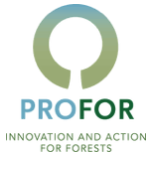The Congo Basin Setting
The Congo basin, the largest in Africa and second only to the Amazon basin globally, covers an area of 3.4 million Km2, and includes most of the Democratic Republic of the Congo, Republic of the Congo, and the Central African Republic, and parts of Zambia, Angola, Cameroon, Tanzania, Burundi, and Rwanda. It is covered with a dense hydrologic network and is currently dominated by forest as the primary land cover.

The Congo basin tropical rainforest, considered to be the second lung of Earth, has an approximate area of 2 million Km2 and is the second largest tropical rainforest in the world next to the Amazon. The Congo basin is located in the western equatorial Africa, The basin is located between longitudes 12 °E - 34 °E and latitudes 9.3 °N to 13.4 °S.
The Democratic Republic of Congo forest area covers over 1.1 million Km2, while the country’s area is approximately 2.3 million Km2. Hence, approximately just under half of the basin is comprised is comprised of forests.

Population
The Congo basin was sparsely populated for centuries while other parts of the world had started becoming populated. Only at the end of the first millennium did populations start settling in more accessible areas in the east, west, and also some parts of the central Congo basin that intensified dramatically over time over the next millennium.

The basin is currently home to 139 million people (estimated 2020), the basin population is expected to increase dramatically in the future. Central Africa region is estimated to increase by 60% in 2035 and double in 2050. Population growth will migrate into the forested areas. This will require additional agriculture production and will put additional stress on the forest for land clearing.
The density of population in the basin is about 30 people/ Km2. There are a few and rapidly growing urban agglomerations in the Congo basin – Kinshasa stands out as one of the most populated and rapidly-growing cities in Africa.


Poverty: The basin is one of the poorest in Africa. The countries of the basin account for a substantial portion of the poverty in Africa as shown below, with a majority of the population in extreme poverty in countries like the DRC, Burundi, Rwanda, and the CAR. Within the basin, large parts of the DRC near the middle and downstream reaches are particularly poor as well as the parts of western Tanzania and northern Zambia that are in the basin.

Fragility:
Most of the primary countries of the Congo basin are considered to be fragile and conflict-prone. For example, the interactive map below shows conflict and protest events in recent times.
Ecomomy:
Even with a few rapidly growing cities like Kinshasa dominating the formal GDP contribution in the Congo basin, most of the Congo basin countries contribute little to the regional GDP (especially when viewed in an Africa context) that derives primarily from urban areas.


The Congo basin is heavily dependent on its natural resources for its exports. For example, in the DRC, the major exports are primarily reliant on mining and to a lesser extent on wood (although these figures capture only legal exports).
These exports are mostly destined to Asia (especially China) and within Africa (especially Zambia).
Development Challenges:
The Congo basin faces a number of development challenges. The countries of the Congo basin rank among the lowest globally in terms of the Human Development Index (e.g. 179 for DRC, 138 for the Republic of Congo, 185 for Burundi, 188 for the Central African Republic, 159 for Tanzania and 143 for Zambia).
In addition to the need for improved basic services and poverty alleviation, the countries of the basin are also exploring ways in which they can develop in a sustainable manner building on their human and natural resource endowments.
A key challenge is to better understand the complex forest-climate-water interactions in the basin. Of all the major river basins, the Congo Basin is the least studied basin in world. Monitoring stations for precipitation and discharge reached their peak in the 1950’s-1960’s, declined in the 1980’s. Today, many stations are either currently not working or working intermittently which prevents a long-term time series.
Bushmeat still a significant part of the diet in the Congo basin. As the economy expands, there will be pressure to convert land to agriculture. Currently, a key driver of deforestation is from agriculture so this can be expected to increase. Illegal logging and poaching are also significant challenges.
In urban areas, there is a lack of access to electricity although there is sufficient hydropower from Inga I and Inga II. This leads citizens to resort to fuelwood for heating and cooking. There is also a heavy reliance on wood but more specifically charcoal in urban areas. The Congo Basin has a lot of untapped minerals where the Congo Basin is assumed to hold 18% of the natural minerals. Mining is currently informal or artisanal for cobalt, gold, diamonds, copper and oil or under exploration.
The current state of the transport network has prevented further development, but this has also stemmed an increase in deforestation given governance and capacity challenges that stymie the best intentions of the countries to adopt sustainability objectives.
A major challenge of the Congo basin is to develop sustainably without enhanced deforestation.

